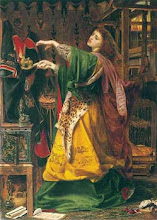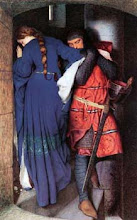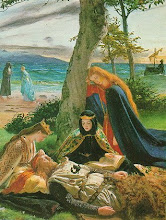Jul 1 2008 by Darren Devine, Western Mail
French historians have suggested King Arthur was indeed a Welshman despite years of English “spin” claiming the mythical figure as their own.
As part of a major conference into the legend, academics say that if the king ever existed he was probably from Wales with strong links to Brittany, in northern France.
And far from being English – a ploy, they say, to appeal to nationalist sentiment – he would actually have been the sworn enemy of the Anglo-Saxons.
The organisers of the event at Rennes University, in Brittany, say the fable of Arthur and Camelot has been continually updated by English nationalists keen to bring back the Age of Chivalry.
Being held next month, the conference and exhibition – King Arthur a Legend in the Making – will suggest English historians, artists and writers conspired to create a fictitious national hero.
Curator of the Rennes exhibition Sarah Toulouse said: “These stories deal with universal themes. The earliest fragments of the tales can be traced back to Wales in the seventh century.
“But by the 13th century stories based on the Arthurian legends were being told right across Europe.”
When the British Empire was at its zenith, writers like the Victorian poet laureate Alfred Lord Tennyson depicted King Arthur as an upstanding Englishman whose masculine virtues saw him try to create heaven on earth.
Mrs Toulouse added: “King Arthur is a mythical figure who was invented at a certain point in history for essentially political reasons.”
The tales of Camelot, Excalibur and Arthurian derring-do have long been popular throughout Europe, with the earliest images of the king found in Italy, dating from about 1120. They also quickly spread as far apart as Iceland and found particular popularity in rural Brittany, although French historians have not gone as far as trying to claim the king as French. “It would be out of the question for us to say that,” said Mrs Toulouse.
Alan Wilson, a Welsh authority on Arthur, agreed with many of the conference’s claims, even claiming he has discovered evidence the monarch famed for his Knights of the Round Table lived and died here.
He says the nation is missing out on a tourism bonanza by ignoring our connections to the legendary leader.
In the early 1980s Mr Wilson, along with Arthurian co-author Baram Blackett, found what they claimed was the King’s memorial stone at the small ruined church of St Peter-super-Montem on Mynydd-y-Gaer, near Bridgend.
A decade later, after using deep ground metal detection equipment, the two say that a cross weighing 2.5lb with an inscription reading “Pro Anima Artorius” (For The Soul Of Arthur) was among several articles discovered. They say the National Museum of Wales was offered both items for analysis, but the offer was declined.
Mr Wilson said despite writing to Culture Minister Rhodri Glyn Thomas about the strength of Wales’ claims on King Arthur, his work is being ignored here.
The writer, who is originally from Cardiff but who now lives in Newcastle, claims historical records from the life of St Illtyd, Arthur’s cousin who buried the monarch, show his body was taken up the Ewenny River.
It was later placed in a cave near Pencoed following his death in 579AD, says Mr Wilson.
The 76-year-old author, whose latest work on the leader was the King Arthur Conspiracy, said the King’s body was then moved to the church where it was buried under a crypt.
Mr Wilson, who believes Arthur’s mythical kingdom of Camelot was in an area now known as Castlefield in Cardiff, said, “I gave them (Assembly officials) copies of our books last year and met the First Minister Rhodri Morgan’s private adviser.”
Mr Wilson, who worked in shipbuilding as a master planner and received commendations from both the Italian and Swedish Governments, added: “The Culture Minister [Rhodri Glyn Thomas] was due to meet us, but ducked out at the last minute. We’ve sent them documents within the last six weeks.
“But it seems the Welsh establishment don’t want tourists. We’ve made monumental discoveries that could create a tourist bonanza like you can’t imagine. You’re sitting on a tourism gold mine in Wales.”
A spokesman for Assembly tourism organisation Visit Wales said overly exploiting every part of Wales said to have connections to Arthur would ruin the visitor experience.
He added: “In addition, the Arthurian story is not unique to Wales since many other parts of the UK and France can claim and demonstrate strong links with the great legend.”
Laying claim to the legend
Almost every corner of the UK has laid claim to the legend of King Arthur. Here we highlight just a few of the places associated with the King:
Authors Alan Wilson and Baram Blackett say Arthur’s kingdom of Camelot was in the Castlefield area of Cardiff.
Tintagel, in Cornwall, has also had a long association with Arthur and the area’s castle is said by local legend to have been the King’s fortress.
Glastonbury Abbey has been taken to be the Isle of Avalon, where Arthur was said to have gone to be healed of his wounds following the Battle of Camlann in 537. Late tradition assumes that he died and was buried there. Other legends have it that the Island of Avalon is the Isle of Aval in northern Brittany.
Stories of King Arthur holding court at Caerleon, near Newport, stretch back to the time of Geoffrey of Monmouth in the 12th century and further still to the oral traditions set down in the Mabinogion.


































0 comments:
Post a Comment